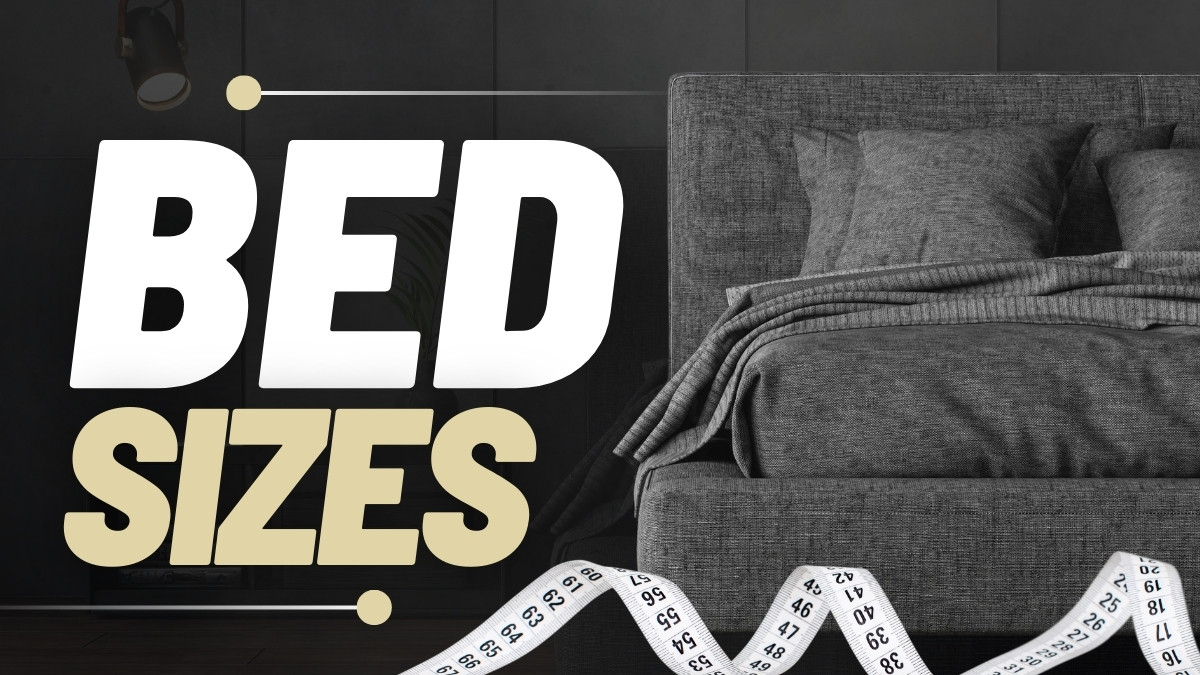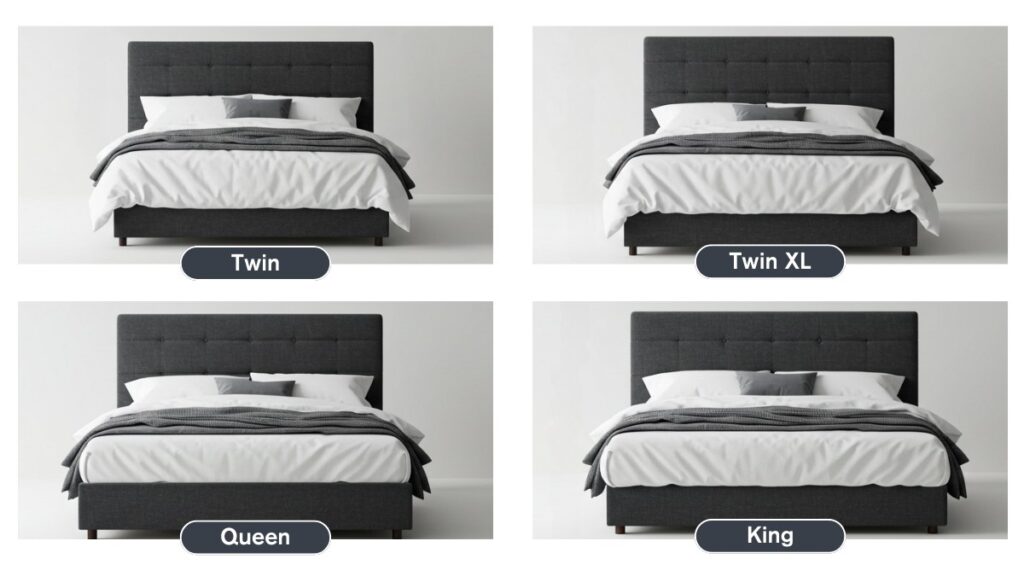
When discussing bed sizes, it’s important to understand that the measurements refer to the dimensions of the bed base where the mattress will sit, not the bed frame. There are multiple bed sizes from Twin being the smallest to King being the largest.
So, if you’re wondering what’s the best bed size for you, depending on your sleeping style, stay tuned. We’ll answer all these questions, take a look at the various types of bed sizes, and see which fits your unique sleep pattern.
Different Bed Sizes in Order
When discussing bed sizes, it’s important to understand that the measurements refer to the dimensions of the bed base where the mattress will sit, not the bed frame. The bed frame will always have larger external measurements to accommodate the mattress and provide structural support. However, we’re not discussing external dimensions in this article.
So, a “queen-size bed” actually means a bed frame designed to fit a queen-size mattress. This is why we often use the terms “bed” and “mattress” interchangeably, especially when talking about size for convenience.
Here’s a list of the most common bed sizes in order from smallest to largest, along with their dimensions:
Twin
A twin is the smallest of the standard bed sizes. It can hold a mattress that measures approximately 38 inches wide and 75 inches long. Because of its relatively small size, a twin bed is an excellent choice for children and teenagers. The small size of a twin bed can also be convenient for single adults living in a studio apartment where space is a concern.
Twin XL
A twin XL is a slightly longer version of the standard twin size bed, measuring 38 inches wide and 80 inches long. It is designed for taller people who still want or need the space-saving dimensions of a twin-size bed.
It is almost equivalent in size to a single European bed, but a twin XL mattress is a bit wider and longer, making it ideal for a guest room.
Full or Double
A double bed measures 54 inches wide and 75 inches long. This is the perfect size bed for a teenager or a single person who is larger and would like more lateral space.
It is also an ideal size bed if you like to have your pet sleep with you. While a full bed is also for a single person, it is nearly twice as wide as a twin, so your room should be at least 10 feet by 12 feet to accommodate a full-size bed.
Queen
A queen bed measures 60 inches by 80 inches and is the most common size found in most homes. It is the most popular size bed for a couple, yet it can also be a luxury size bed for a single person.
There are different variations of queen size beds, especially with certain kinds of sofa beds, so be sure to consider the measurements of any queen bed you’re considering. The minimum room recommended for a queen bed is 10 by 14 feet if you want to have some other furniture besides the bed.
King
There are two king bed sizes. One measures 72 inches wide by 80 inches long, and another slightly wider version measures 76 inches by 80 inches. This bed type is for couples who like to spread out and for families where children and/or pets may occasionally come aboard. The minimum recommended room size for a king bed would be approximately 13 by 13 feet.
Most Popular Queen and King Size Beds
There are many different bed sizes available, but for adults, the most popular ones are queen and king-size beds. We’ll highlight some popular options and provide some information on each size to help you decide which one is right for you.
Olympic Queen
As the name implies, the Olympic queen-size bed is for sleepers who feel they need a little more space to move around. Measuring 66 inches by 80 inches, the Olympic Queen is 6 inches wider than a standard queen, so you have that much more space to find the room you need.
The minimum room size recommended for an Olympic Queen would be in the same ballpark as the standard queen, though a bigger size than the recently mentioned 10 by 14 feet would be better.
California King
A California king bed has the same 72-inch width as the standard King bed, except the length of the California king is 4 inches longer. Like the King size bed, the California King is for couples who like to spread out and have children and/or pets. Because of its added length, the recommended room size for a California King bed would be approximately 14 by 15 feet or bigger.
Wyoming King
The Wyoming King size bed measures a whopping 84 inches by 84 inches and gives you more than enough room for even a tall or oversized couple to sleep comfortably. Needless to say, a larger bedroom is necessary once you cross the line to have one of these oversized bed models.
Texas King
The Texas King bed focuses more on width than length, measuring 98 inches wide and 80 inches long, giving you 14 inches of extra lateral room compared to the Wyoming King. This bed would be for a couple who needs their individual space because they are either a pair of larger people who like to have enough wiggle room or who move around when asleep.
Alaskan King
The Alaskan King bed is one of the three largest beds manufactured commercially. Measuring a luxuriously spacious 108 inches by 108 inches, it is a custom bed not available everywhere and really only suitable for the largest bedrooms.

Kids’ Bed Sizes
What are the different bed sizes for kids? Let’s take a look at the bed size chart for kids.
- A crib or toddler bed measures 28 inches wide and 52 inches long and is meant for babies and toddlers who need to sleep in an enclosed and protected area.
- A junior bed measures 28.5 inches by 63 inches and is commonly referred to as a “small single.” It is only slightly larger than the crib size.
- The twin bed is the smallest of the adult standard bed sizes, 38 inches wide and 75 inches long, and it is for bigger children up to teenagers.
- The twin XL bed is slightly longer than the standard twin, measuring 39 inches wide by 80 inches long, and is for taller teenagers.
Best Bed Sizes for Couples
Either queen size or king size beds are recommended for couples, with the queen size being the most popular. The reason for the greater popularity of the queen size bed is that it provides a comfortable sleep space for couples without taking up too much space in their bedroom, thus allowing more space for upholstered furniture.
On the other hand, if space is not an issue, a king-size bed is better for taller or larger couples because it provides an adequate amount of sleep area.
Best Bed Sizes for Single Sleepers
Depending on your individual needs, a twin size, twin XL, or full size bed are all good choices for single sleepers.
The twin and twin XL are good if space is an issue, for instance, with a studio apartment. To make things more convenient, you can get storage beds for the twin XL, which is slightly better for taller individuals. The full size gives a single person more space to spread out and would probably be a better choice for a one-bedroom apartment if the bedroom is at least 10 by 12 feet in size.
Best Bed Sizes for Families
Depending on the age and number of children in a family, a queen, king, or California King size bed could be appropriate. A queen size would generally work for a couple with a baby or a very small child. A King or California King would be better for multiple children or a slightly bigger child with their own bed who still might want to visit in the middle of the night.
How to Choose the Right Bed Size
Choosing a bed that provides enough space for comfortable movement, temperature regulation, and minimal partner disturbance can contribute to a more restful night’s rest and improve REM sleep.
Adequate space is essential, whether at home or in a care setting; for example, a bed that limits a patient’s ability to turn can lead to discomfort and other complications [1].
So, what are some of the most important things to consider when selecting the right bed among the many standard bed sizes in feet and bed sizes in cm?
1. Consider Your Preferred Sleeping Position
Are you a side or back sleeper? Do you scrunch up in a fetal position, stretch out, or even sleep diagonally? Do you move around a lot? All these factors are essential in determining what size bed you will need.
2. How Many People Will Sleep in It
If you share a bed with another, you definitely will not be able to sleep in anything smaller than a queen size. Some might disagree and include a full-size bed as a possible choice, but if either of you moves around even a little, a full-size bed is not big enough.
3. Bedroom Size and Dimensions
Besides considering the amount of sleeping space you desire, you must also consider whether the bed size and bed frame you want will fit in your bedroom, particularly if you hope to include upholstered furniture like dressers or perhaps bedside tables.
4. Cost
Larger beds can get quite expensive. It’s therefore important to consider what bed size you can afford that will meet your various needs and last you into the future.
5. Mattress Versatility
What is the best mattress you’re considering made of? Features like memory foam, individual spring support, and cooling materials are usually associated with high-quality mattresses and their foundation. It’s also important to check that your mattress has CertiPUR-US and OEKO-TEX certifications, which gives users the confidence that no harmful materials have been used in its construction.
FAQs About Bed Sizes
Here are some questions customers have frequently asked regarding how many types of bed sizes there are and what is the right size for their individual needs.
What are the sizes of each bed?
The different sizes of a bed, ranging from the smallest to the largest, include twin, twin XL, full or double, queen, and king. There are also variations among the bigger sizes, such as Olympic queen, Wyoming king, California king, Alaskan king, and Texas king. When it comes to kids’ beds, the sizes are the crib (a.k.a. toddler bed), junior, twin, and twin XL bed.
Is double the same as full?
Yes. Double is just another name for the full bed, which is 75 in long and 54 in wide. The full or double bed is designed for single sleepers who have outgrown the smaller twin bed. This will give solo sleepers more room to relax in without taking up too much space in the room.
What is a 4 bed called?
A 4 bed is also known as a three-quarter or small double bed. It’s named for how wide it is, which is 4 ft. This “in-between” size is bigger than a twin bed yet smaller than a double bed. It’s a great choice for those who feel cramped with a twin but don’t have enough room for a double.
What size bed for 2 adults?
Two adults who share the same bed can take their pick from the double, queen, and king sizes. The double is a practical option for those who wish to save space while still accommodating both persons. The queen and king are more luxurious alternatives for couples who have more than enough room to make space for it, as well as those who have the budget to invest in them.
Can a 6 foot person fit in a full-size bed?
No. A full bed might be too small for a 6 foot person. After all, it’s only 75 in long, which is just a little over 6 ft. A queen or king, which is slightly longer at 80 in, might be a more comfortable choice for very tall sleepers.
What Are Standard Bed Sizes?
The standard bed sizes in the U.S. and North America are twin, twin XL, queen, king, and California King.
Is 2 Twin XL the Same as California King?
No. Two twin XL beds side by side would be 76 inches by 80 inches, which is the size of a standard king bed. A California King would be 4 inches narrower and 4 inches longer.
Is Twin Size the Same as Single?
A single bed is another name used to refer to a twin bed, so these two terms are used interchangeably.
Is There a Size Between a Twin and a Full Bed?
Yes. A twin XL bed exists between a twin and a full.
Can Two People Sleep on a Full Bed?
A full bed might be tight for two people, but it is usually for one person who would like to spread out a little more.
What Is the Smallest Bed for Adults?
A twin bed is the smallest standard bed size and is capable of hosting a single adult or child.
Is a Twin Bed Okay for an Adult?
Yes. A twin bed is fine for adults sleeping alone if they don’t need to stretch out much.
Do Two Twins Make a King?
No. A twin size bed side by side with another would measure 76 inches wide by 75 inches long, which is 5 inches shorter than a standard king bed.
Conclusion on Bed Sizes
Sleep is an important part of maintaining good health, and the bed you sleep on sets the stage for how restful your sleep will be.
Choosing the right size bed depends on your regular sleeping positions, how much you move around, and whether you sleep alone or with a partner.
Hopefully, this article has enlightened you on the different standard bed sizes and how each one might work with your living circumstances and sleeping style.
 11 Niche Experts
11 Niche Experts
 100+ Product Reviews
100+ Product Reviews
 50+ Tested Products
50+ Tested Products
At BestDaily, our mission is simple: to help you make confident, informed decisions about the products that impact your daily life. Whether you're searching for wellness essentials or lifestyle upgrades, we combine hands-on testing with expert analysis to highlight what truly works.

